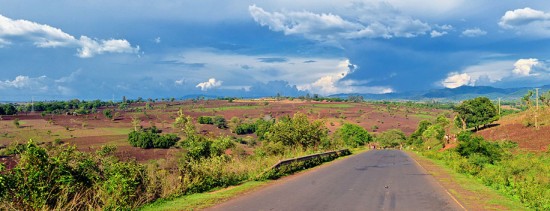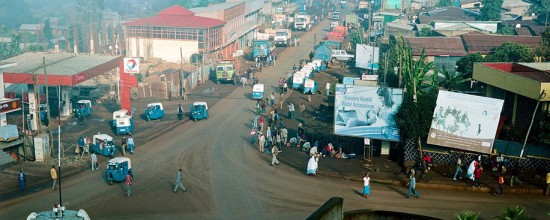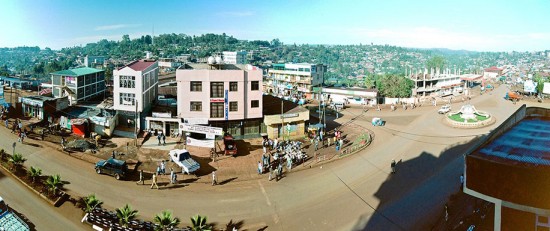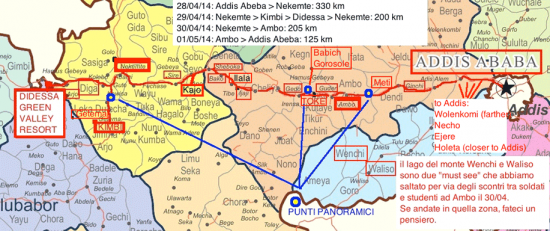




Back to Ethiopia is by Dino Brusco. The trip took place in April-May, 2014 (click on images for larger view):
Good morning everyone. Before approaching this trip, let me briefly introduce myself. I’m 40 yrs old, live in Northern Italy and photography became my passion since April 25th, 2004 when – thanks to a mistake, I did something “different”, that I liked so much to sparkle a real fire inside myself.
Fast forward till February 2012 when my wife and I concluded an adoption in Ethiopia of a very little boy. Unfortunately at the time we stayed only 1 week in Addis to fill all forms and paper and knew nothing but his birthdate and birthplace, Nekemte, 330 km west of Addis Ababa. When in 2014 I hinted I might have quit my company very soon, I booked a trip before it was too late. What I didn’t know was that right a few days before I left, several violent university revolts with Molotov’s, barricades, burned banks and cars etc had sparkled right in that area and soldiers were sent to stop them with use of force and gunfire. We even stumbled upon them, but let’s go with order.
Here’s a home-made map I prepared to show you the area where I wandered in these 4 days out (“punti panoramici” means “landscape viewpoints”):
Keep in mind most of the pictures have been taken from a running van for safety reasons. Thus, this isn’t a showcase of shining, perfectly exposed and pp’ed pictures, rather a series of images and stories I’m sharing with you. This is a summary of a 144-pages long photo book I prepared for my adoptive son.
Day 1: April 28th, 2014, Monday, from Addis to Nekemte
On April 28th I arrived in Addis, joined my guide, driver and friend, got a local sim card to save on international communications and immediately left for Nekemte. The road – very differently from my expectations, was newly asphalted by Chinese companies and it took 7 hours (included lunch) to get to Nekemte because of both speed limits and van speed. In 4 days we covered 850 km and only two points weren’t asphalted. No side lighting, though.
The road passes through both plains and plateaus. Especially near Addis, lots of businesses are about wood and stones, necessary for the capital to grow. Wood is used instead of metal also for house scaffoldings. This means a huge quantity of wood, more than strictly necessary.
For this reason in Ethiopia were imported Eucalyptus trees from Australia by a Swiss doctor, because of the very fast growth of these plants compared to the others. In a few years, the trees reach 15-20 meters in height. These two images relate to that:
On a side note, just this kind of material was then used to make barricades in Ambo on April 30th when clashes between soldiers and students occurred when we were there. Several raws of rocks were laid out on the main street so that no one could pass.
Towns and villages aren’t always marked on the map and when I was back, the most part of my work was placing every picture in the right place: I can’t count how many hours I spent back and forth by looking city and villages names or recognizing houses I had spotted on day 1 rather than day 3 or 4. Here are a very few of them
1) – My crew in Nekemte (film photo, day 2) in front of our van
2) – Unconventional “hotel” outside Addis, day 1
Don’t ask me who had the brilliant idea to convert this plane into an hotel, yet that’s it!
3) – On the road between Meti and Ambo, day 1
4) – Main street in Ambo, day 1.
Three notes here: first Ambo is the only relevant town going to Nekemte and this means an overall better and more modern environment; second, this street would have later been blocked with rocks and rubbles on day 3; third, while in Addis it’s Toyota with its white and blue vans being the undisputed leader in the streets, in most part of the country, it’s the Indian Tagrow Bajaj with its blue three-wheeled cars that takes the lion’s share as a cheap transportation mean for common people that otherwise walk.
5) Business in Guder, day 1
6) – Synthesis of life outside Toke, day 1
Along the road I caught this little boy watching the woman lugging a heavy bag on her back. For what happened after, I think this is a real summary of what I saw in the subsequent days for most people here (women and children).
7) – Agriculture with basic tools and techniques (day 3)
In Nekemte, the Desalegn hotel, right in the city center, is nothing to brag about, despite the city is about 100.000 inhabitants and growing, their food is definitely better than their rooms. I managed to take a few film pics from the hotel before it was too late and so I did the next morning, after a quite strange night where we had also a black out.
Day 2: April 29th, 2014, Tuesday, Nekemte and its surroundings
8) Nekemte from Desalegn hotel, two 18mm film pictures stitched together
9) Nekemte, students (film photo, day 2)
10) Nekemte, morning traffic (film photo, day 2)
On day 2, we meant to go to a nature reserve and sleep there, yet thankfully we didn’t, we couldn’t even find the entrance to it and honestly sleeping near crocodiles, rhinos and lions wasn’t exactly my dream. Besides, having left at home my longest lens, a 300mm, everything would have been useless anyway. However, this day had a couple of reasons to be unforgettable.
First, we made a terrible mistake. As told before, we didn’t know what had just happened over there, so when I, the only “white” in 50 km, jumped off the van with a large DSLR right in front of one of the two Universities where the revolts had begun a big red flashing arrow on my head screamed everywhere with loudspeaker ” JOURNALIST ! ” Guess what ? Within 10 minutes we were stopped by police and soldiers who escorted us at the town hall where the Major of Nekemte in person interrogated us. What was even worse, my guide and the local people had different ethnicities, Amhara and Oromo and this only further complicated things.
Thankfully, I had with me not only a picture of me with my wife and my adopted son but also a full list of adoptive documents that proved that my son was found right outside the university where the revolt started, then the Major understood the terrible misunderstanding and let us go, BUT.. we were prohibited to leave the van, to take further pictures there and I had to delete ANY picture I took in Nekemte, with two police officers checking me while doing it. What a pity. I wanted to save at least one from where my son was found but it wasn’t possible. Thankfully again, they didn’t notice I had also a FILM camera that allowed me to save a very few pics.
Back to day two. Besides this unexpected (and kind of frightening, to be honest) event, I started realizing more and more how people lived there; since every photo had to be taken outside the city and behind the van windshield, many of my images look identical or very similar and had to correct on all of them some contrast, when shooting backlit. While on day 1 I mostly looked naively at people, women and kids, searching for some kind of likeliness with my son’s face, this was the day I realized how hard was their life and however I was even able to spot some hope for them. I also discovered some really beautiful places, green valley and mango valley first ..and I met Brilalà.
11) Brilalà. We stopped on the way to Kimbi (south west of Nekemte) to take a few pics of the beautiful surroundings, when at once this little girl showed up from the meadows and got close, repeating “Brilalà, brilalà” – I managed to ask her to pose a moment, although she was probably surprised and not used to it.
12) Green valley – definitely one of the most inspiring views over here, not much far from where we met Brilalà. This is the northern part of the Natural reserve we should have entered but no one knew the road to it. What you see here is actually only the right half of it – it extended at least as much on the left side yet there was the road “spoiling” the overall effect. These are 4 shots stitched
13) Road market
We stopped here and suddenly became the “attraction” of locals, clearly not used to see many tourists over here. Aside the many vegetables and legumes I had never seen, I realized people here use to chew bamboo or sugar canes to clean teeth and whiten them.
14) Kimbi – at the farthest and southmost point of our trip, about 400 km far from Addis, we reached this ugly and messy town where I saw a girl living in a concrete box near a sewage channel
15) Getema (where I tried a sort of HDR)
16) Mango Valley (two pictures)
West of Nekemte, toward Gimbi, an even lonelier environment opens to our eyes. Houses are always rarer and mango plantations show up for many km along the road. The only apparent business here for people is exactly selling mango and other fruits to the occasional passers-by
Mango sellers:
Chat sellers: Chat is another story. This is something commonly sold in Ethiopia, now and then you see boys with this plant in their hands and it’s considered some kind of “drug” (in Italy is prohibited)
By chewing its leaves , you should “feel good and more responsive”; I tried it but didn’t like at all.
Women, students and children
Now finally the time has come to talk about people, women and children first. If the road is the backbone for civilization, women are the backbone of everything moves.
They have three main duties: collecting wood for fire and water in large tanks they lug for kilometers under the sun. Only third is children care. Thankfully, especially among the young ones, school is becoming a very positive reality. Most students I could see walking down the road (every day they walk from 5 to 10 km to reach school with their friends and then to go back home) were women and this leads to another interesting subject: time.
Time in Ethiopia is relative. Being most of people (outside Addis, but also there) without any transportation mean but their feet, everything is slowed down to a pace we western aren’t able to make ours. When someone says: “let’s meet tomorrow”,the implicit statement is “Come tomorrow, as soon as I’m there, we’ll meet” The very most part of my pictures are about people walking on the road, no surprise Ethiopian athletes often win marathons.
17) women and wood or other loads
Here you may complain they are very similar images, yet I’d invite you to think how many hundreds times I saw what you see here. How hard is life for women down there, so when some of you complain about a “headache” look again at these pics and thank God to be born where you live!
For me is definitely unconceivable to see them lugging such large and heavy loads. When I was a boy, I too had farm works but I have never moved such an amount of wood for so long. Chapeau!
Only in Addis women may have a chance like these three I spotted. The first one is the owner of a little souvenir shop; I met the second near the National Museum where the hominid “Lucy” is kept When money isn’t an issue, Ethiopian women look to be very classy and beautiful. Of course, poorness is always there too, like the latest two, a begger and the most unfortunate woman outside the Court: she’s gone there to abandon her daughter
Of course, while women “must” work, men “must” live comfortably (relatively speaking) and “command” them. Look at these two pics:
Students
Students here use a school suit (or whatever you call it); every school has a color, usually it’s a single (or double) tint vest and everyone must wear one, so you can easily spot those bunches of boys and girls going to or coming from school. Here are a few: note it’s mostly girls.
Homework in Ethiopia 🙂 I’m not much expert of panning, yet I’m glad I could take it decently sharp where I needed it most.
Children
Forget our weeping and vitiated western children. Ethiopian children are self-sufficient and let alone at very early age. Most of them, especially outside Addis, are very poor and fated to have farm works or (the luckiest ones) lead a herd of cows or sheep to its grazing; some care for the littler kids. Beyond Nekemte, mango sellers alternate to simple beggars asking for money
This one was lugging two water tanks while his mother was caring for the baby
This is one of the very few I could approach: his eyes were so sad !
Thankfully I could also (and finally) spot a boy who wasn’t happy rather it seemed not worried for life:
Back to Addis trough clashes
Day 3, April 30th, 2014, Wednesday, from Nekemte to Ambo
Day 3 was really hectic, especially in the afternoon/evening. We left Nekemte and with a trick I was even able to record on my phone the place where my son was born and everything was fine till Ambo (theoretically we should have gone to mount Wenchi / Wolisso that day, but we didn’t) where everything was blocked and lots of cars queued.
Someone said that clashes were ongoing between students and soldiers so we decided to come back to Guder, not much far, and have lunch in a restaurant just aside the falls with the same name, hoping everything would have solved soon.
Here’s a quick snap I took at Guder falls >
This was around 14, we lost about 2 hours for lunch and at 16.30 we were back queued in the outskirts of Ambo, when we saw two pick-ups fully packed with soldiers in their battle suit running in. Within 15 minutes we heard a couple of explosions and some gunfire about 1 mile away from us.
From that point onwards the sim card I had bought in Addis to exchange sms/whatsapp messages with my friends and family became hot. Here you see people waiting for the situation to solve outside Ambo:
And here a burned truck on our way (day 1)
Add another 30 minutes and people started “escaping” from Ambo. This was probably the worst moment since there was no other way to reach Addis than this – the “alternative” would have forced us to cover more than 1000 km in less than a work day which was simply out of question. Thankfully, when we thought we were “lost”, people started again to re-enter Ambo, so we did too. Of course my camera was tucked away. With extreme care and driving very slowly, we managed to reach the city center where soldiers had seized and locked students into the university campus. Rubbles and burned cars everywhere; our driver meant to proceed for Mount Wenchi yet the road was so destroyed that he desisted and once back in Ambo, we found an old colonial hotel right in front of us, with armed guards. Only two rooms, very old with no light nor running water were left, however we accepted the deal. We were given a candle and these are two photos from that night: our dinner outside and my room candle-lit
This was the large hotel garden with a huge sycomore in the middle.
Day 4, May 1st, 2014: From Ambo to Addis Ababa Most images have been left behind, yet I liked this one.
Here are a few pics I chose from Addis
View exiting the airport (2011 compact p/s photo)
Ongoing roadworks for the construction of a motorway (this is the only place where I saw metallic scaffolding)
while this is what they usually look like (again old pic): a whole mess of tiny wooden poles bound together (call them safe!)
What I have to say about Addis mostly refers to my previous visit in 2011/2012, although at the time I had only a compact p/s (I wasn’t sure about personal safety at the time and decided to travel light). First, Addis is a city growing very quickly, yet infrastructures and social life can’t keep up with it and the simplest way to notice it is a quite messy city, especially in the “popular” part, far from the diplomatic block where only a very few luxury cars or UN pick-ups show up from time to time.
If you allow me, here are both realities and pictures are from 2011/2012, sorry.
24-lanes wide( (3+3)x4 ) crossroad with no traffic light, stop or other signal regulating the car flow.
Diplomatic block: much larger avenues, much less cars
Second: poorness. Two images for all. First, in 2011/2012 I had already noted how poor and miserable are some people there, forced to live on the sidewalk dividing the avenues, like this guy (2014 photo):
The second image regards “communications”. Despite the great poorness of certains slums in Addis, they still have something missing everywhere else in Ethiopia: satellite dishes (2011 image) – Outside Addis, in fact, they are still a luxury feature, not to be found anywhere else.
A bittersweet note: in Addis Ababa, Chinese already opened some of their “massage saloons” that are so popular right now over here, although clearly related to a certain kind of prostitution that can be masked or hidden behind the “body massage” voice. Here’s one:
Houses and food
While in Addis houses are mostly modern or decent, outside you may basically find three kind of houses all with ground floor only.
1) round straw hut, probably what we still think when imagining old
African people living in the savannah:
2) the most frequent is a house made of wood and straw where mud and cow shit are fitted into the spaces – this is how they look once finished. My guide told me that while original traditional houses had straw in the roof, now there’s no longer enough straw for everyone, so people prefer cheap metal sheet – which has a longer durability, about 20 yrs, but on the other hand has much worse thermal properties, becoming an oven in summer and a very cold in winter.
3) brick and concrete-made houses – this is the least frequent kind and it’s the only one you may see with 1 upper floor. I appreciated a lot their rice (which is however something not specifically related to Ethiopia) while something you might want to try (if you like spicy food) are Tibs (prn T’bbs) >
small pieces of meat served sizzling on the moment on a hot cup with Ethiopian mustard and berberé, a sweet red pepper powder. They even eat it at breakfast ! I liked it a lot, much more than their traditional “Injera” a spongy bread wet with vinegar that’s eaten with meat or vegetables and sauces.
Religion
Religion is important in Ethiopia and while there’s an important Jewish community (they say to be the descendants of King David and Queen of Saba), there are also lots of (Orthodox or Evangelical) Christians and their masses and functions go beyond our imagination, both for length and fasting times, longer and more frequent than in our tradition. Besides, religious services are kept at very early times (look for yourself this church outside Addis when calls for mass!)
There you can also observe the strange “bustrofedical alphabet” used in Ethiopia, definitely unintelligible for us. While Oromiya is slowly moving toward latinization of its language, easier to read and pronounce, the Amhara region (Addis Ababa) is strictly bound to this kind of writing.
Religion is also present on daily stuff, names and activities: this pic, taken in the outskirts of Addis, sums it all: this van has a cross with written aside “Everything comes from God” or something like this.
In Addis the most important cathedral is St. Saviour (2012 photo):
and in Nekemte is St. Gabriel
You may see more pictures of the trip here, or get the whole photo book, entirely translated in English, with the articulated story in a 13”x11” pro pearl color pages here.



















































































